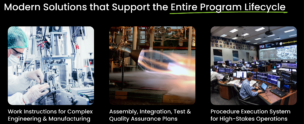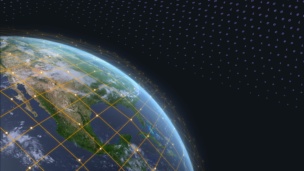NASA’s Artemis program will return astronauts to the Moon and enable a future of deep space exploration. A key element of the program’s success is Gateway, the first orbital lunar space station, which will serve as a jumping-off point to the lunar surface.
Maxar Space Systems is building Gateway’s Power and Propulsion Element (PPE), the module that will provide the space station with power, maneuvering, attitude control, and communications systems. Built on Maxar Space Systems’ trusted Maxar 1300 ™ series bus and with cutting-edge solar electric propulsion technology, PPE will make Gateway one of the most powerful spacecraft ever flown.
Powering a Lunar Outpost
Gateway will serve as an outpost for deep space exploration, providing a sustainable waypoint that facilitates humanity’s return to the lunar surface and provides a launchpad toward our ultimate goal—Mars. It will also be a hub for uncrewed scientific missions.
As a multifunctional lunar space station, Gateway will serve as a command center, astronaut habitat, research platform, service module, and communications relay. It will also be a cornerstone for international collaboration, with contributions from Japan, Canada, the European Space Agency, and more.
Solar electric power: PPE leverages Maxar Space Systems’ heritage electric propulsion bus (on the Maxar 1300 series product line), used on commercial programs since the early 2000s, to help NASA push the boundaries of what’s possible in deep space. PPE will be able to supply at least 48 kilowatts of power to the electric propulsion system, making it the highest power solar electric propulsion spacecraft ever developed.
PPE’s solar electric propulsion system provides greater fuel economy for lower-cost missions:
- Once deployed, PPE’s two roll-out solar arrays (ROSAs) will generate power required by the electric propulsion system to ionize and accelerate Xenon gas.
- As a result, PPE is 5 times more efficient than chemical propulsion systems.
- Sourcing energy from the sun reduces propellant mass, enabling PPE to carry more cargo.
- PPE will use its state-of-the-art power, propulsion, and control systems to sustain Gateway in its unique orbit around the moon.
An Adaptable Legacy Bus
The PPE is built on the Maxar 1300 series bus, which has served government and commercial customers since 1989. With more than 90 such spacecraft on orbit today, the Maxar 1300 series is one of the world’s most popular and reliable satellite platforms. For Gateway, PPE will provide high-rate comms capabilities between the station, the Moon’s surface, and Earth.
Originally designed as a geostationary communications and remote sensing system, the Maxar 1300 series features modular panel construction that enables straightforward and flexible spacecraft customization. This adaptability optimizes the bus for a variety of missions. In addition to Gateway’s PPE, Maxar Space Systems has also used this bus for missions such as:
- NASA’s Psyche: This mission is en route to explore a deep space asteroid made of metal to offer insight into how Earth was formed.
- Sirius SXM-9: This satellite will be a new geostationary communications satellite for SiriusXM.
- TEMPO/IS40e: TEMPO, a hosted NASA payload on Intelsat’s IS-40e satellite, is the first space-based instrument to provide hourly monitoring of major air pollutants during the daytime across North America at high spatial resolution.
PPE’s Progress
The PPE program, managed by NASA’s Glenn Research Center in Cleveland, Ohio, has achieved several milestones in 2024 on its journey from concept to reality.
In March 2024, Maxar Space Systems completed the spacecraft critical design review and delivered the spacecraft structure to the propulsion lab to begin propulsion hardware integration. The company continues to support NASA in subsequent safety and other required reviews as PPE moves through the program’s propulsion module production phase. Maxar Space Systems’ suppliers continue building and delivering flight hardware, such as PPE’s ROSA, which is taking shape and passing key inspection points.
As the first element of NASA’s Lunar Gateway, PPE will be integrated and launched with Northrop Grumman’s Habitation and Logistics Outpost (HALO)–Gateway’s first pressurized element and humanity’s first permanent home away from Earth’s orbit.
On the Horizon
As the Maxar Space Systems’ PPE team looks toward the end of the year, they’re preparing for yet another major milestone—PPE’s full systems integration, assembly, and test checkpoint. This will pave the way for the spacecraft to be equipped with all its major subsystems, including early versions of flight software, with the goal to complete baseline system testing by mid-2025. Throughout these stages, Maxar Space Systems continues to collaborate closely with NASA and the greater Gateway and Artemis teams to ensure steady progress on this groundbreaking mission.
2025 promises to be an exciting and busy year for the Artemis program as the teams advance toward their shared goals. The addition of PPE to the company’s long-standing flight heritage showcases Maxar Space System’s trusted ability to deliver cutting-edge technology for cislunar missions and government customers.
Learn more about Maxar Space Systems and NASA’s Gateway PPE.




